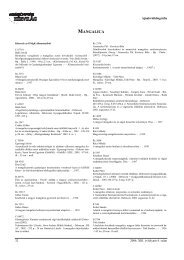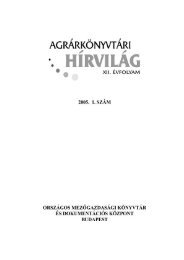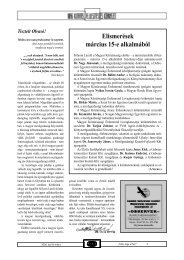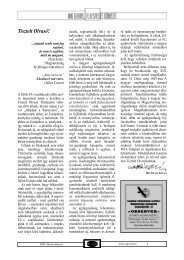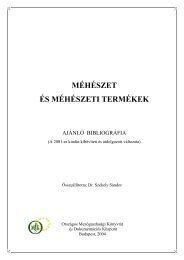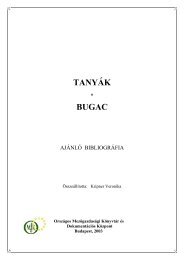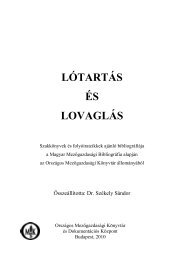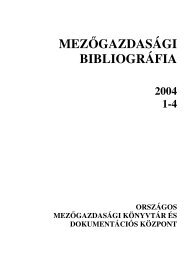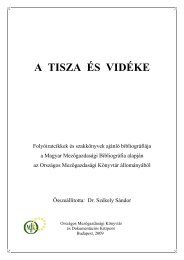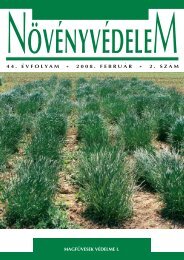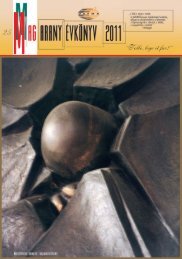hUNGARiAN AGRicUltURAl RESEARch
hUNGARiAN AGRicUltURAl RESEARch
hUNGARiAN AGRicUltURAl RESEARch
Create successful ePaper yourself
Turn your PDF publications into a flip-book with our unique Google optimized e-Paper software.
varieties and – in international<br />
cooperation – to prepare their<br />
morphological description. The<br />
environmental conditions in<br />
Hungary are primarily suitable for<br />
the production of quality white<br />
wine. The majority (80%) of grape<br />
varieties cultivated before the<br />
phylloxera epidemic in the 19 th<br />
century were white wine varieties.<br />
Except the Kadarka cultivar,<br />
originating from the Balkans,<br />
which was once grown on large<br />
areas and the less important Kék<br />
Bakator cultivar, no other old<br />
Hungarian red wine varieties were<br />
found to offer high quality,<br />
making its widespread cultivation<br />
reasonable (Table 1).<br />
On the basis of the results of<br />
our variety assessment research of<br />
several years, the Csókaszôlô<br />
cultivar (Figure 1) with its high<br />
must degree and medium acid<br />
content showed superior traits.<br />
Csókaszôlô gave excellent quality,<br />
spicy, full-flavoured, fragrant,<br />
full-bodied, harmonious red wine<br />
with velvety tannin content. The<br />
outstanding harvest results of the<br />
variety presented in Table 2 was<br />
later confirmed by other experiments<br />
as well (S.-né Éles; A.<br />
Lôrincz; Zs. Varga, 2008). After<br />
propagating the 10 vine-plants<br />
preserved in the gene bank, the<br />
variety is evaluated in multi<br />
location experiments in several<br />
wine regions of the country<br />
(Balatonboglár, Eger, Etyek-Buda,<br />
Szekszárd, Villány, Zala). With its<br />
unique character and taste, the<br />
Csókaszôlô cultivar may contribute<br />
to the highly demanded<br />
increase of the range of grapevine<br />
choice.<br />
Clone selection of ‘Hungarica’<br />
grapevine varieties<br />
The clone selection of old<br />
‘Hungarica’ grape varieties is one<br />
of the priority tasks of the Institute,<br />
the achievements of which are<br />
summarised in Table 3.<br />
Table 1: Harvest results of ‘Hungarica’ red wine grape varieties<br />
(1998–2008)<br />
Pécs, Research Institute for Viticulture and Oenology – Central site<br />
Variety<br />
Yield (kg/<br />
m 2 )<br />
Must degree<br />
(Mm°)<br />
Ágasfark 1.5 16.1 9.0 17 7-Oct<br />
Bajor, feketefájú 0.9 17.6 7.4 6 20-Oct<br />
Bajor, kék 1.8 16.4 9.7 9 2-Oct<br />
Bakator, kék 1.7 15.4 11.7 22 27-Sep<br />
Bakszem 0.5 17.1 9.7 29 3-Oct<br />
Csókaszôlô 0.8 20.2 9.4 1 20-Sep<br />
Fekete balafánt 0.8 16.6 8.4 13 7-Oct<br />
Gorombaszôlô 0.2 16.9 11.8 1 4-Oct<br />
Halápi 1.0 18.3 8.9 23 5-Oct<br />
Járdovány, fekete 0.2 18.4 8.5 0 16-Oct<br />
Kadarka 1.1 17.2 8.7 37 1-Oct<br />
Kéklôpiros 1.6 14.3 9.5 7 11-Oct<br />
Ködös 1.7 15.7 8.9 9 5-Oct<br />
Pécsi dinka 0.6 18.1 6.6 11 11-Oct<br />
Purcsin 0.5 17.8 12.3 12 10-Oct<br />
Tótika 1.8 15.5 7.7 18 10-Oct<br />
A new selection cycle was<br />
started in 2001 to define variants<br />
and clones better suiting the<br />
requirements of quality production.<br />
First, old plantations with<br />
great diversity of form were<br />
quested (Figure 2). The findings<br />
of explorations on the cultivars<br />
Kadarka, Olasz rizling and Furmint<br />
are summed up hereunder.<br />
Titratable<br />
acidity (g/l)<br />
Kadarka<br />
Bunch rot<br />
(%)<br />
Date of<br />
harvest<br />
Table 2: Harvest results of the Csókaszôlô cultivar<br />
Pécs, Research Institute for Viticulture and Oenology – Central site<br />
Year<br />
Yield<br />
(kg/m 2 )<br />
Must degree<br />
(Mm°)<br />
Titratable<br />
acidity (g/l)<br />
Bunch rot<br />
(%)<br />
Date of<br />
harvest<br />
1998 0.3 19.5 7.7 0 30-Sep<br />
1999 0.8 24.1 8.1 0 18-Oct<br />
2000 1.0 22.5 7.3 0 26-Sep<br />
2001 1.2 18.4 9.9 0 12-Sep<br />
2002 0.6 21.0 11.6 0 4-Sep<br />
2003 1.2 20.3 8.6 0 18-Aug<br />
2004 1.3 18.9 10.8 0 22-Sep<br />
2005 0.8 16.9 13.3 7 23-Sep<br />
2006 0.6 18.1 12.0 0 19-Sep<br />
2007 0.9 20.4 6.6 0 28-Aug<br />
2008 0.5 22.0 7.6 0 20-Oct<br />
Average 0.8 20.2 9.4 1 20-Sep<br />
Selection was carried out to<br />
find plants less sensitive to bunch<br />
rot which have loose clusters,<br />
small or medium sized berries,<br />
thicker skin, deeper and more<br />
uniform colouring of berries.<br />
Another important requirement<br />
was that the vines with the above<br />
26 Hungarian Agricultural Research 2009/3–4



